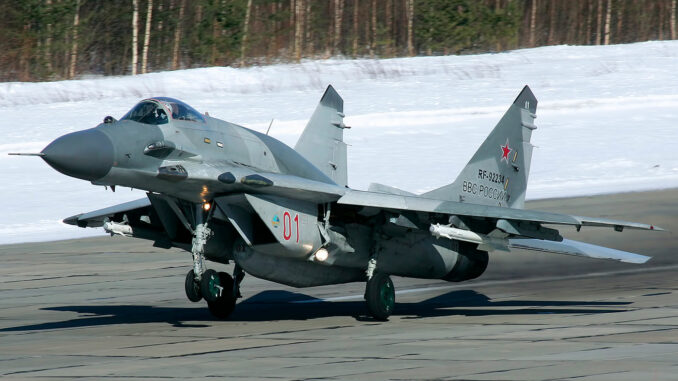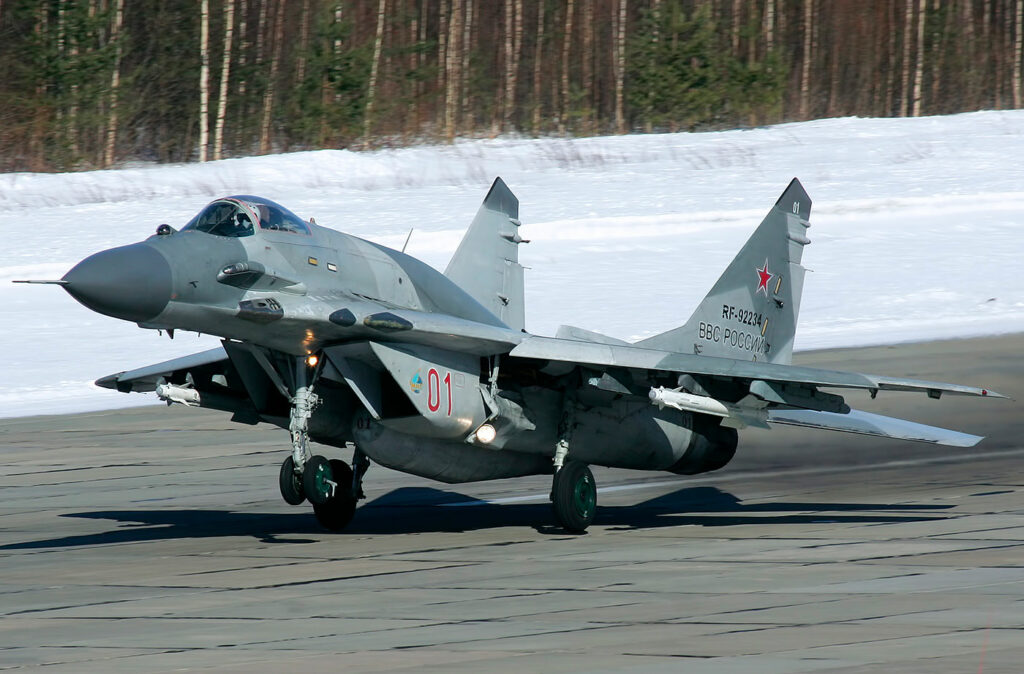
Russia is keeping the MiG-29 in its military fleet. Technical, strategic, and economic analysis of this decision.
The Mikoyan MiG-29 entered active service in 1983. Designed to compete with the American F-16, this fourth-generation Russian fighter jet continues to be modernized more than forty years after its first flight. Despite more advanced alternatives such as the Su-35 and Su-57, Moscow is still investing in upgrades to the MiG-29. This choice is neither sentimental nor based on political criteria. It is based on precise calculations related to Russian military doctrine, internal industrial constraints, operating costs, fleet maintenance, and operational reality. Understanding this strategy requires a rigorous technical and geopolitical analysis.

The operational logic behind modernization
The MiG-29, in its most recent versions such as the MiG-29SMT and MiG-29UPG, is far from obsolete. Russia has decided to extend the operational life of this aircraft for several reasons related to high- and medium-intensity warfare.
Russian doctrine calls for the use of mixed fleets in conventional conflicts. The MiG-29 plays a specific tactical role here. It is a light aircraft capable of taking off from short or damaged runways. It is designed to operate close to the front lines, with high maneuverability at low altitudes. This operational profile remains useful in areas such as Ukraine or the Caucasus, where intervention distances are short.
The modernized MiG-29 is equipped with the Zhuk-ME radar with a mechanical antenna, with a detection range of 120 km against fighter-type air targets. It can track up to 10 targets and engage 4 simultaneously. The aircraft can also fire R-77 medium-range air-to-air missiles (range: 80–100 km) and air-to-ground guided missiles such as the Kh-29. It is therefore becoming multi-role, although its air-to-ground capabilities remain limited compared to a Su-34.
Finally, the Russian Air Force must compensate for the losses suffered since February 2022. Between 15 and 20 MiG-29s have been delivered to Ukraine since 2022 by Slovakia and Poland. Many Russian aircraft have been shot down or damaged. Restoring local superiority also requires the modernization of existing fighter aircraft. This includes the installation of L-150 Pastel electronic warfare systems, infrared countermeasures, and communications jammers. The MiG-29 is therefore suitable for medium-intensity contested environments.
A low-cost transitional solution
The cost of a modern combat platform is considerable. A Su-35S costs around €80 million. A Su-57, although still produced at a low rate, already costs €110 million per unit, not including maintenance or training costs.
In comparison, the modernized MiG-29SMT costs around €20 to €22 million per unit. The aircraft’s airframe is often pre-existing. The modernization includes the overhaul of the RD-33 engines, the integration of larger fuel tanks (range increased to 2,100 km with ventral tank), the replacement of the cockpit with digital multifunction displays, and the integration of data links.
The Russian Air Force, which operates around 90 MiG-29s in 2024, including 30 SMTs, can thus maintain a sufficient number of operational aircraft without drawing on the budget earmarked for fifth-generation aircraft.
Secondary air forces (naval air force, tactical aviation in the eastern military districts) will also benefit from this modernization without penalizing strategic units. This will allow for budget rationalization.
Finally, the ground infrastructure is already adapted to the MiG-29. Hangars, lifting equipment, simulators, engine test benches—everything is already in place. Modernization therefore costs much less than re-equipping an entire air base for a more complex aircraft.
The MiG-29 as an industrial and diplomatic lever
The MiG-29 remains a strategic lever for the Russian aviation industry. Since the merger of MiG with Sukhoi within United Aircraft Corporation (UAC), the production lines at Sokol and Lukhovitsy have been running at reduced capacity. Maintaining the production of parts, engines, and avionics systems supports thousands of jobs.
Russia also uses the MiG-29 as an export product. More than 1,600 units have been manufactured since the 1980s. Around 100 are still in service outside Russia, notably in India, Serbia, Algeria, Myanmar, and Peru. Not all of these countries can afford to replace their fighter jets with 4.5 or 5 generation aircraft.
Russia therefore offers turnkey modernization packages, as was the case for India (MiG-29UPG), or resales of refurbished MiG-29s. This generates revenue and maintains influence in areas targeted by Russian foreign policy. The 2020 Algerian contract provided for the delivery of 14 MiG-29M/M2s, for an estimated $400 million, or about $28 million per unit.
This policy supports Russian military exports in a context of Western sanctions and growing competition with China. The MiG-29 is a vehicle for presence in niche markets.

Technical limitations and the choice made
Modernizing the MiG-29 does not eliminate its weaknesses. The Zhuk-ME radar remains inferior to the Su-57’s AESA N036 radar. The airframe suffers from low endurance (1.5 hours on mission without refueling). Its payload capacity is limited to 4,000 kg, compared to 8,000 kg for a Su-30SM. Its range without refueling remains short: approximately 1,500 km with a standard load.
The RD-33 engines are known for their high fuel consumption and frequent maintenance. In addition, their infrared emissions make them vulnerable to modern heat-seeking missiles. In terms of electronics, the lack of an active AESA radar or omnidirectional passive sensors limits situational awareness.
But these weaknesses are well known. Russia is not seeking to make the MiG-29 a competitor to the F-35 or the Rafale. It is using it as a tool for saturation, tactical defense, training, and support. In a context of attrition warfare, having a reliable, inexpensive, and adaptable fighter aircraft remains relevant.
War Wings Daily is an independant magazine.